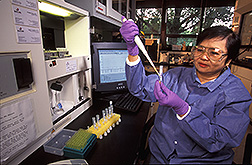This page has been archived and is being provided for reference purposes only. The page is no longer being updated, and therefore, links on the page may be invalid.
Read the magazine story to find out more. |
|
New Detection Methods Improve Food Safety
By Jim CoreJanuary 6, 2005
A new technique developed by the Agricultural Research Service (ARS) to detect heat-resistant toxins in foods such as ham, milk and eggs should help researchers and inspectors detect toxins that cause gastroenteritis.
Marjorie B. Medina, a research chemist at the ARS Eastern Regional Research Center in Wyndmoor, Pa., developed a biosensor-based method that detects chemical signals from toxin-producing bacteria and provides information about their specific biological activities.
Bacteria produce toxins under stressful conditions, such as when they are too crowded, denied food or fighting back against antibiotics. Generally, conventional heating and processing kill food-borne bacteria but do not destroy their toxins.
In her studies, Medina focused on Staphylococcus aureus enterotoxins A (SEA) and B (SEB). Her biosensor test makes use of what's called surface plasmon resonance (SPR) to detect toxins. SPR uses light reflected off thin metal films. Attached to these films are toxin or antitoxin antibody molecules. When these molecules bind to the film surface, they change the way light refracts. These changes in light intensity, monitored by an optical detector, provide a measure of how much toxin, if any, is present in a food sample.
One potential use for the method would be to detection enterotoxins in liquid whole eggs. Medina's semi-automated method will be able to detect several bacterial toxins in a single food sample.
In addition to detecting bacteria and their toxins, Medina and other chemists at the Wyndmoor center are using advanced technologies to develop methods to screen, detect and confirm multiple chemical residues--such as veterinary drugs and pesticides--in food products.
Read more about this research in the January issue of Agricultural Research magazine.
ARS is the USDA's chief scientific research agency.

